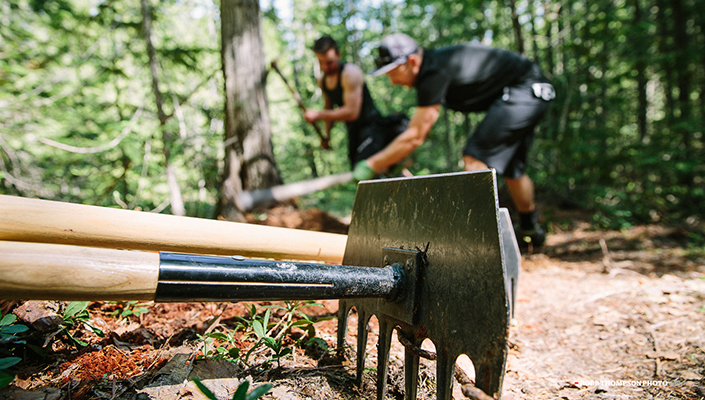
Trail building is one of the best ways to spend your time out of the saddle. Giving back to your local riding scene can help refresh your love for cycling, giving you a sense of pride and ownership in your local trails. Besides, come fall, we as riders are more ready to put our bikes down and pick tools up.
If you're new to trail building or don't have faith in what skills you have, now's the time to join your local trail society. Your local trails didn't just appear in the world, they were built and are maintained by passionate riders, so why not be one of those people?
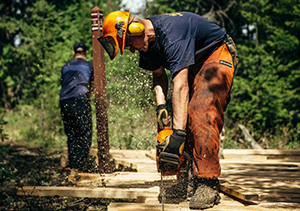
image: Robb Thompson
Your local trail society will have all the tools and information you need to start moving dirt. More importantly, trail societies usually have a plan that spans the short and long term of trail development and maintenance. Routine trail maintenance days are usually scheduled every couple of weeks or so, with major trail days happening a few times a year. A calendar of events should be easily found; these events often include trail building courses as well as lessons on how to use power tools like a chainsaw, brush saw, and ditch witch.
If you don't have a local trail society, well, start one! We often forget that all our local trails, trail societies, and bike culture started from somewhere. If you're the only person building the first trails in your area, you might feel somewhat alone, but chances are you're not. Even if there are only three of you, that's enough to get your trail society started.
Organizations like IMBA (International Mountain Biking Association) are a fantastic resource for everything related to trail building and advocacy and are a great starting place for any one person or organization looking to get started. Yes, you will need government approval, in most cases, to build trails on public land, and governments tend to listen to representatives of an organization a lot better than they do individuals.
Here's why you should help build and maintain your local trails and why fall is the best time to do it.
1. Trail traffic
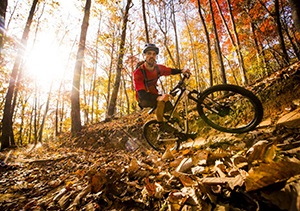
image: adventureprojects.net
In both the spring and fall, there is less traffic on the trails making it easier to take your time and get a trail repair job done properly. During shoulder seasons you have more time to do larger trail revisions, even closing the trail down completely if needed. Less trail traffic also means there is a reduced risk of people accidentally ruining your fresh work. In some cases, fresh trails needs to sit and drain all the water out of the soil; if people ride through this, it can undo a bunch of your hard work and cause premature erosion.
If you're building a new trail, then less traffic means there's less of a chance of people riding your trail before it's completed. This is extremely important as some critical elements may be missing. Haven't placed a bridge over a creek? Missing the landing to a big drop? You definitely do not want people riding your unfinished trail and put at risk of getting hurt.
2. Weather
No matter what hemisphere you live in, it's the in-between seasons that have the better weather for trail building. Summer is often too hot and the soil can often be too dry to shape properly. Hot weather is hard on trails and you might be tempted to grab your shovel and start re-shaping lines, but this can end in disaster as the dirt you dug up just dries out and blows away with the wind.
Save summer for trail clearing; instead, focus on cutting back the brush and clearing any downed logs that end up on the trails. Summer is also a decent time to flag new trails or new lines on existing trails, you just want to leave the actual digging until fall or spring. With hot weather often comes fire bans, and without the ability to burn slash piles, your trail might be delayed until things cool down.
Winter is often too cold, too wet, or too snowy to get any real trail work done. You want to avoid building when there is increased runoff from snow melt or heavy rains as the excess water can cause unwanted erosion. If you live in a warmer climate or desert (e.g. California, Arizona, Spain), then you may want to disregard this; winter could be primo time in those climates to be building trails and moving dirt. Just keep in mind, regardless of locale, to leave things alone when there’s lots of runoff.
RELATED: Wet weather survival guide
3. Planning

image: Tristin Kenney
Ah, planning, the often overlooked, but immensely critical part of trail building and maintenance. Planning takes longer than expected, especially if you're needing government approval for your new trails (which you should). The approval process for new trails is often a long drawn out process and there are often public consultations, council meetings, and endless official documents that need to be submitted before you are granted permission to start building new trails. We often only think about this in the summer when we are eating-sleeping-breathing cycling, so by the time you get approval it's fall or the following spring.
Like we mentioned earlier, it really does help to speed up the process if you are involved in an organization. Being involved with a local organization that has a large membership gives the government tangible numbers that show the per-capita interest in cycling. This per-capita number almost directly relates to the amount of funding that can be provided for trail development and maintenance. Simply put, if the government knows a large percentage of the population rides bikes they're more likely to give more funding.
4. Community
Maybe it's all those memories of going back to school in the fall, but there's just something about the end of summer that makes us want to group together and get something done! Fall is the perfect time to celebrate your love for cycling community by organizing trail day potluck dinners and work bees. Yes, the weather may sometimes be unfavorable, but bonding over bowls of hot chili after a long day fixing trails is what gives a group of people that community feeling.
RELATED: Building Community by Bike
When people are organized and have a common goal they can get a lot done in a short period of time. Having a sense of community while building trails can last all year round and provides momentum for any and all bike related activities. With a strong community you will find your race days full of willing volunteers, you will find your trail society membership list growing, and you will find smiles on the trails all season.
5. Fitness
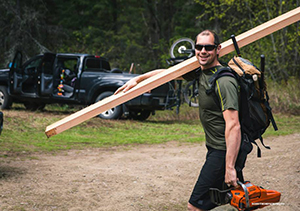
image: Robb Thompson
When the leaves start turning many of us end up not riding as much as in the months prior. Maybe it's the busy schedule we fall back into, or maybe it's the weather, but without as much time in the saddle our fitness may start to slip. With all the hiking, digging, raking, and carrying heavy stuff, trail building is a great way to stay in shape. Conversely, if you've been going hard, this is the cross-training diversion you need.
When building a trail you almost always underestimate the number of times you will walk it from end to end. What's even more surprising is the motivation you will have to keep doing it, even when you're carrying a chainsaw and a load of lumber. For whatever reason, it always seems the spots in a trail that need the most maintenance are the hardest spots to get to. The trek up gets even more difficult when you have to carry a load of 2x4's on your shoulder. It may be tough, but think about how good this is for your fitness, now and into next year's riding season. Challenge yourself to build a new trail as part of your fall fitness plan!
5. Inspiration
One of the biggest mistakes trail builders make is not getting out and knowing what else is going on around them. Too much of a good thing can quickly turn bad and sometimes builders forget to diversify their trials. Over time we tend to stick with what works for us and that can lead to a repetitive interpretation of the landscape. Branching out and looking at how similar trail challenges are being tackled by different trail builders can help you diversify your approach to building.
Spending a summer riding different areas and different types of terrain can help inspire us to build better trails at home. Like all artists, trail builders sometimes use completely different methods and tools to solve the same types of problems and this can be seen in how trails flow from start to finish. Riding as many different types of trails as possible is the best way to keep your own trail flow fresh. So, spend the summer riding and the fall building.
The time spent planning, designing, and building trails is also personally inspiring and refreshing. You'll enjoy a satisfaction from your efforts to share your love of mountain biking and be inspired and to ride and share the trails come next riding season.
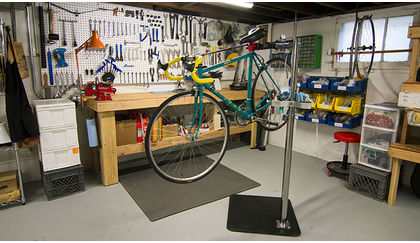
RELATED ARTICLE:
Save money by setting up your own home bike workshop
If minor repair bills are starting to sting, try setting up your own workshop! BikeRoar gives you some tips on how setting up a home workshop can save you... READ MORE
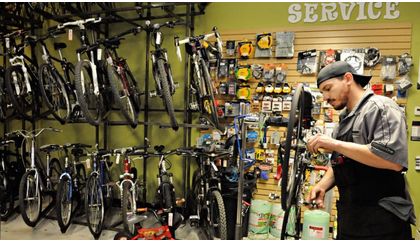
RELATED ARTICLE:
How to get faster and better service at a bike shop
2016 was a good year for big breakthroughs in the bike industry BikeRoar selected the most innovative... READ MORE



